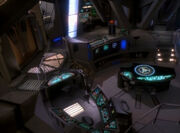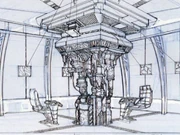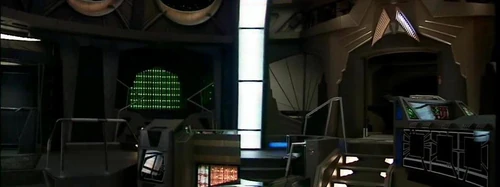Vedek Dukat (talk | contribs) m (→Cardassian design: Actually... we should) |
Renegade54 (talk | contribs) m (formatting) |
||
| (34 intermediate revisions by 20 users not shown) | |||
| Line 1: | Line 1: | ||
| − | [[ |
+ | [[File:Deep Space 9 ops 2369.jpg|thumb|The Operations center of Deep Space 9]] |
| + | [[File:Engineering stations on DS9s ops.jpg|thumb|The engineering stations in ops]] |
||
| ⚫ | |||
| + | [[File:Ops command table.jpg|thumb|The command table and the "pit"]] |
||
| + | {{aquote|And this is Ops..."<br />"The heart and soul of Deep Space 9.|Julian Bashir''' and '''Vadosia|2369|The Forsaken}} |
||
| ⚫ | |||
| − | ==Cardassian design== |
+ | == Cardassian design == |
| ⚫ | On [[Cardassian]] stations such as [[Deep Space 9]]/[[Terok Nor]], the command center was a circular area located at the top of the main structure, with overhead windows giving a view of the [[star]]s and [[ship]]s docked at the upper [[docking pylon]]s. It contained, among other things, the commander's office, a [[turbolift]], a [[transporter]], and a [[viewscreen]]. The design was such that all present were required look up to the commander's office and also isolated the commander to a degree; rather than a [[captain's chair]], the station commander's "seat of power" was in what would otherwise be a [[ready room]]. ({{DS9|Emissary}}) |
||
| ⚫ | The centralized nature of the operations center also meant that, unlike most starships, in which primary controls were accessible from [[main engineering]] if desired, the operations center was the only location with such access. This made it a prime target for hostile forces, particularly in the case of Terok Nor, as the risk of a [[Bajoran]] revolt was significant. In order to minimize such risks, Ops could be sealed off from the rest of the station if necessary. ({{DS9|Civil Defense}}) |
||
| ⚫ | On [[Cardassian]] stations such as [[Deep Space 9]]/[[Terok Nor]], the command center |
||
| ⚫ | Many functions that would have otherwise been performed in main engineering could be performed in the "pit", located directly below the [[viewscreen]]. Among other things, this allowed the commander to keep from showing signs of weakness, because crucial tasks could be performed out of sight during [[hail]]s. |
||
| ⚫ | The centralized nature of the operations center also |
||
| + | Ops also had a [[replicator]]. ({{DS9|Babel|Second Sight|Civil Defense}}) |
||
| ⚫ | Many functions that would otherwise |
||
| ⚫ | |||
| ⚫ | |||
| − | Ops also has a [[replicator]]. |
||
| ⚫ | |||
| + | Other starbases and space stations had operations centers as well, such as [[Empok Nor]] and the [[Tevak shipyards]]. ({{DS9|Empok Nor|Tacking Into the Wind}}) |
||
| − | <br clear="all"> |
||
| ⚫ | |||
| + | In [[2364]], the [[senior staff]] of the {{USS|Enterprise|NCC-1701-D|-D}} evacuated to the operations center of [[Starbase 74]] after what appeared to be a failure of the ship's [[antimatter]] [[magnetic containment field]]. From ops, the ''Enterprise'' crew continued to monitor the ship's autopiloted flight away from the starbase, as well as later attempting to locate and contact the ship when it became apparent that it had been stolen by the [[Bynar]]s. ({{TNG|11001001}}) |
||
| ⚫ | |||
| − | Other starbases and space stations have operations centers as well. |
||
| − | ==Background |
+ | == Background information == |
| + | [[File:Early Ops concept art 1.jpg|thumb|left|Early Ops concept art 1]] |
||
| ⚫ | The oval-shaped windows in Ops were occasionally seen on screen, but their placement |
||
| + | [[File:Early Ops concept art 2.jpg|thumb|Early Ops concept art 2]] |
||
| − | |||
| ⚫ | * The oval-shaped windows in Ops were occasionally seen on screen, but their placement was odd in that one would have to crane one's neck to look directly at them. [[Herman Zimmerman]] originally wanted to have a moving starfield in the windows but later realized it was unnecessary. On most occasions, the windows on the set were used for lighting, camera positioning, etc. |
||
| − | Oddly, the [[turbolift]] in DS9's Ops is not fully enclosed as one might imagine; when lowering, it resembled an old-fashioned elevator, wherea a gate was pulled across the entrance but there was no doorway. It appears that the turbolift seals its doors after leaving Ops, given evidence seen in "[[The Forsaken]]" ([[DS9]]) and other episodes, where it is clearly sealed while in motion. |
||
| + | * Oddly, the [[turbolift]] in DS9's Ops was not fully enclosed as one might imagine; while all decks had outer turbolift doors that protected people from falling into the [[turboshaft]], the cab featured no inner doors, exposing the turboshaft to the passengers like in an old-fashioned elevator. This is seen in {{DS9|The Forsaken}}: just before [[Lwaxana Troi]] and [[Odo]] get stuck in turbolift 7 on their way to upper pylon 3, the exposed inside of the turboshaft can be seen pass by, including deck level doors and conduits. DS9's Ops however did not feature an outer shaft door like other levels did, as the cab came right out of the floor. It seems like the turboshaft on Ops sealed itself by leaving (a part of) the cab's ceiling on Ops floor level, but as scenes usually cut right at the moment where the cab disappeared or entered, it is hard to say what really happened. Further, the turbolift moved at very low speeds while entering or exiting ops, as opposed to higher speeds when inside the shaft. |
||
| − | |||
| ⚫ | |||
[[de:Operations Center]] |
[[de:Operations Center]] |
||
| + | [[ru:Оперативный центр]] |
||
| + | [[Category:Station sections]] |
||
Revision as of 18:33, 4 November 2014

The Operations center of Deep Space 9

The engineering stations in ops

The command table and the "pit"
"The heart and soul of Deep Space 9."
An operations center (also known as Ops) was the command and control facility of a space station or outpost. (DS9: "Civil Defense", "Meridian") It was the equivalent of the bridge of a starship.
Cardassian design
On Cardassian stations such as Deep Space 9/Terok Nor, the command center was a circular area located at the top of the main structure, with overhead windows giving a view of the stars and ships docked at the upper docking pylons. It contained, among other things, the commander's office, a turbolift, a transporter, and a viewscreen. The design was such that all present were required look up to the commander's office and also isolated the commander to a degree; rather than a captain's chair, the station commander's "seat of power" was in what would otherwise be a ready room. (DS9: "Emissary")
The centralized nature of the operations center also meant that, unlike most starships, in which primary controls were accessible from main engineering if desired, the operations center was the only location with such access. This made it a prime target for hostile forces, particularly in the case of Terok Nor, as the risk of a Bajoran revolt was significant. In order to minimize such risks, Ops could be sealed off from the rest of the station if necessary. (DS9: "Civil Defense")
Many functions that would have otherwise been performed in main engineering could be performed in the "pit", located directly below the viewscreen. Among other things, this allowed the commander to keep from showing signs of weakness, because crucial tasks could be performed out of sight during hails.
Ops also had a replicator. (DS9: "Babel", "Second Sight", "Civil Defense")
Other designs
Other starbases and space stations had operations centers as well, such as Empok Nor and the Tevak shipyards. (DS9: "Empok Nor", "Tacking Into the Wind")
In 2364, the senior staff of the USS Enterprise-D evacuated to the operations center of Starbase 74 after what appeared to be a failure of the ship's antimatter magnetic containment field. From ops, the Enterprise crew continued to monitor the ship's autopiloted flight away from the starbase, as well as later attempting to locate and contact the ship when it became apparent that it had been stolen by the Bynars. (TNG: "11001001")
Background information

Early Ops concept art 1

Early Ops concept art 2
- The oval-shaped windows in Ops were occasionally seen on screen, but their placement was odd in that one would have to crane one's neck to look directly at them. Herman Zimmerman originally wanted to have a moving starfield in the windows but later realized it was unnecessary. On most occasions, the windows on the set were used for lighting, camera positioning, etc.
- Oddly, the turbolift in DS9's Ops was not fully enclosed as one might imagine; while all decks had outer turbolift doors that protected people from falling into the turboshaft, the cab featured no inner doors, exposing the turboshaft to the passengers like in an old-fashioned elevator. This is seen in DS9: "The Forsaken": just before Lwaxana Troi and Odo get stuck in turbolift 7 on their way to upper pylon 3, the exposed inside of the turboshaft can be seen pass by, including deck level doors and conduits. DS9's Ops however did not feature an outer shaft door like other levels did, as the cab came right out of the floor. It seems like the turboshaft on Ops sealed itself by leaving (a part of) the cab's ceiling on Ops floor level, but as scenes usually cut right at the moment where the cab disappeared or entered, it is hard to say what really happened. Further, the turbolift moved at very low speeds while entering or exiting ops, as opposed to higher speeds when inside the shaft.

